Text Classification
Text classification is the process of categorizing text documents into predefined categories or labels.
Papers and Code
Identifying social isolation themes in NVDRS text narratives using topic modeling and text-classification methods
Jun 18, 2025Social isolation and loneliness, which have been increasing in recent years strongly contribute toward suicide rates. Although social isolation and loneliness are not currently recorded within the US National Violent Death Reporting System's (NVDRS) structured variables, natural language processing (NLP) techniques can be used to identify these constructs in law enforcement and coroner medical examiner narratives. Using topic modeling to generate lexicon development and supervised learning classifiers, we developed high-quality classifiers (average F1: .86, accuracy: .82). Evaluating over 300,000 suicides from 2002 to 2020, we identified 1,198 mentioning chronic social isolation. Decedents had higher odds of chronic social isolation classification if they were men (OR = 1.44; CI: 1.24, 1.69, p<.0001), gay (OR = 3.68; 1.97, 6.33, p<.0001), or were divorced (OR = 3.34; 2.68, 4.19, p<.0001). We found significant predictors for other social isolation topics of recent or impending divorce, child custody loss, eviction or recent move, and break-up. Our methods can improve surveillance and prevention of social isolation and loneliness in the United States.
LCS-CTC: Leveraging Soft Alignments to Enhance Phonetic Transcription Robustness
Aug 05, 2025Phonetic speech transcription is crucial for fine-grained linguistic analysis and downstream speech applications. While Connectionist Temporal Classification (CTC) is a widely used approach for such tasks due to its efficiency, it often falls short in recognition performance, especially under unclear and nonfluent speech. In this work, we propose LCS-CTC, a two-stage framework for phoneme-level speech recognition that combines a similarity-aware local alignment algorithm with a constrained CTC training objective. By predicting fine-grained frame-phoneme cost matrices and applying a modified Longest Common Subsequence (LCS) algorithm, our method identifies high-confidence alignment zones which are used to constrain the CTC decoding path space, thereby reducing overfitting and improving generalization ability, which enables both robust recognition and text-free forced alignment. Experiments on both LibriSpeech and PPA demonstrate that LCS-CTC consistently outperforms vanilla CTC baselines, suggesting its potential to unify phoneme modeling across fluent and non-fluent speech.
UniFGVC: Universal Training-Free Few-Shot Fine-Grained Vision Classification via Attribute-Aware Multimodal Retrieval
Aug 06, 2025Few-shot fine-grained visual classification (FGVC) aims to leverage limited data to enable models to discriminate subtly distinct categories. Recent works mostly finetuned the pre-trained visual language models to achieve performance gain, yet suffering from overfitting and weak generalization. To deal with this, we introduce UniFGVC, a universal training-free framework that reformulates few-shot FGVC as multimodal retrieval. First, we propose the Category-Discriminative Visual Captioner (CDV-Captioner) to exploit the open-world knowledge of multimodal large language models (MLLMs) to generate a structured text description that captures the fine-grained attribute features distinguishing closely related classes. CDV-Captioner uses chain-of-thought prompting and visually similar reference images to reduce hallucination and enhance discrimination of generated captions. Using it we can convert each image into an image-description pair, enabling more comprehensive feature representation, and construct the multimodal category templates using few-shot samples for the subsequent retrieval pipeline. Then, off-the-shelf vision and text encoders embed query and template pairs, and FGVC is accomplished by retrieving the nearest template in the joint space. UniFGVC ensures broad compatibility with diverse MLLMs and encoders, offering reliable generalization and adaptability across few-shot FGVC scenarios. Extensive experiments on 12 FGVC benchmarks demonstrate its consistent superiority over prior few-shot CLIP-based methods and even several fully-supervised MLLMs-based approaches.
CATVis: Context-Aware Thought Visualization
Jul 15, 2025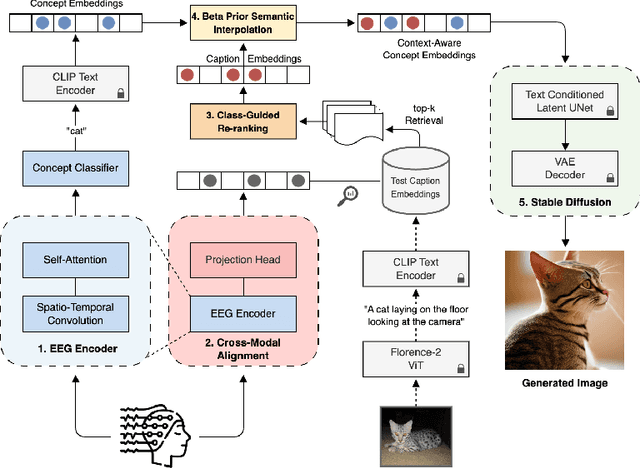
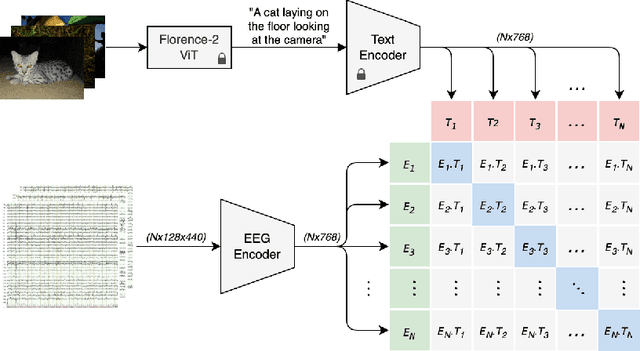

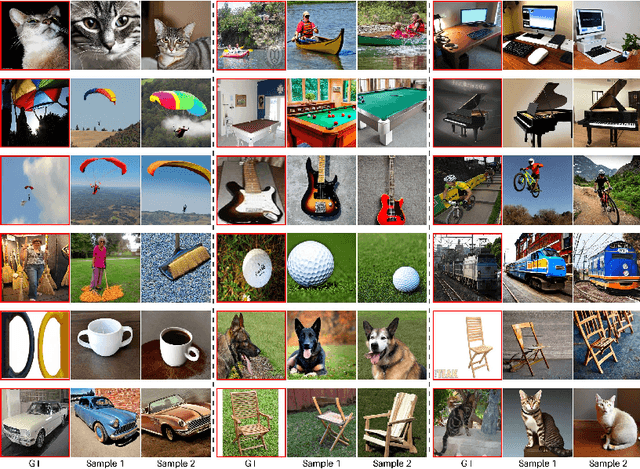
EEG-based brain-computer interfaces (BCIs) have shown promise in various applications, such as motor imagery and cognitive state monitoring. However, decoding visual representations from EEG signals remains a significant challenge due to their complex and noisy nature. We thus propose a novel 5-stage framework for decoding visual representations from EEG signals: (1) an EEG encoder for concept classification, (2) cross-modal alignment of EEG and text embeddings in CLIP feature space, (3) caption refinement via re-ranking, (4) weighted interpolation of concept and caption embeddings for richer semantics, and (5) image generation using a pre-trained Stable Diffusion model. We enable context-aware EEG-to-image generation through cross-modal alignment and re-ranking. Experimental results demonstrate that our method generates high-quality images aligned with visual stimuli, outperforming SOTA approaches by 13.43% in Classification Accuracy, 15.21% in Generation Accuracy and reducing Fr\'echet Inception Distance by 36.61%, indicating superior semantic alignment and image quality.
NonverbalTTS: A Public English Corpus of Text-Aligned Nonverbal Vocalizations with Emotion Annotations for Text-to-Speech
Jul 17, 2025Current expressive speech synthesis models are constrained by the limited availability of open-source datasets containing diverse nonverbal vocalizations (NVs). In this work, we introduce NonverbalTTS (NVTTS), a 17-hour open-access dataset annotated with 10 types of NVs (e.g., laughter, coughs) and 8 emotional categories. The dataset is derived from popular sources, VoxCeleb and Expresso, using automated detection followed by human validation. We propose a comprehensive pipeline that integrates automatic speech recognition (ASR), NV tagging, emotion classification, and a fusion algorithm to merge transcriptions from multiple annotators. Fine-tuning open-source text-to-speech (TTS) models on the NVTTS dataset achieves parity with closed-source systems such as CosyVoice2, as measured by both human evaluation and automatic metrics, including speaker similarity and NV fidelity. By releasing NVTTS and its accompanying annotation guidelines, we address a key bottleneck in expressive TTS research. The dataset is available at https://huggingface.co/datasets/deepvk/NonverbalTTS.
FHSTP@EXIST 2025 Benchmark: Sexism Detection with Transparent Speech Concept Bottleneck Models
Jul 28, 2025Sexism has become widespread on social media and in online conversation. To help address this issue, the fifth Sexism Identification in Social Networks (EXIST) challenge is initiated at CLEF 2025. Among this year's international benchmarks, we concentrate on solving the first task aiming to identify and classify sexism in social media textual posts. In this paper, we describe our solutions and report results for three subtasks: Subtask 1.1 - Sexism Identification in Tweets, Subtask 1.2 - Source Intention in Tweets, and Subtask 1.3 - Sexism Categorization in Tweets. We implement three models to address each subtask which constitute three individual runs: Speech Concept Bottleneck Model (SCBM), Speech Concept Bottleneck Model with Transformer (SCBMT), and a fine-tuned XLM-RoBERTa transformer model. SCBM uses descriptive adjectives as human-interpretable bottleneck concepts. SCBM leverages large language models (LLMs) to encode input texts into a human-interpretable representation of adjectives, then used to train a lightweight classifier for downstream tasks. SCBMT extends SCBM by fusing adjective-based representation with contextual embeddings from transformers to balance interpretability and classification performance. Beyond competitive results, these two models offer fine-grained explanations at both instance (local) and class (global) levels. We also investigate how additional metadata, e.g., annotators' demographic profiles, can be leveraged. For Subtask 1.1, XLM-RoBERTa, fine-tuned on provided data augmented with prior datasets, ranks 6th for English and Spanish and 4th for English in the Soft-Soft evaluation. Our SCBMT achieves 7th for English and Spanish and 6th for Spanish.
DS@GT at CheckThat! 2025: Detecting Subjectivity via Transfer-Learning and Corrective Data Augmentation
Jul 08, 2025This paper presents our submission to Task 1, Subjectivity Detection, of the CheckThat! Lab at CLEF 2025. We investigate the effectiveness of transfer-learning and stylistic data augmentation to improve classification of subjective and objective sentences in English news text. Our approach contrasts fine-tuning of pre-trained encoders and transfer-learning of fine-tuned transformer on related tasks. We also introduce a controlled augmentation pipeline using GPT-4o to generate paraphrases in predefined subjectivity styles. To ensure label and style consistency, we employ the same model to correct and refine the generated samples. Results show that transfer-learning of specified encoders outperforms fine-tuning general-purpose ones, and that carefully curated augmentation significantly enhances model robustness, especially in detecting subjective content. Our official submission placed us $16^{th}$ of 24 participants. Overall, our findings underscore the value of combining encoder specialization with label-consistent augmentation for improved subjectivity detection. Our code is available at https://github.com/dsgt-arc/checkthat-2025-subject.
Seq vs Seq: An Open Suite of Paired Encoders and Decoders
Jul 15, 2025The large language model (LLM) community focuses almost exclusively on decoder-only language models, since they are easier to use for text generation. However, a large subset of the community still uses encoder-only models for tasks such as classification or retrieval. Previous work has attempted to compare these architectures, but is forced to make comparisons with models that have different numbers of parameters, training techniques, and datasets. We introduce the SOTA open-data Ettin suite of models: paired encoder-only and decoder-only models ranging from 17 million parameters to 1 billion, trained on up to 2 trillion tokens. Using the same recipe for both encoder-only and decoder-only models produces SOTA recipes in both categories for their respective sizes, beating ModernBERT as an encoder and Llama 3.2 and SmolLM2 as decoders. Like previous work, we find that encoder-only models excel at classification and retrieval tasks while decoders excel at generative tasks. However, we show that adapting a decoder model to encoder tasks (and vice versa) through continued training is subpar compared to using only the reverse objective (i.e. a 400M encoder outperforms a 1B decoder on MNLI, and vice versa for generative tasks). We open-source all artifacts of this study including training data, training order segmented by checkpoint, and 200+ checkpoints to allow future work to analyze or extend all aspects of training.
Cardiac-CLIP: A Vision-Language Foundation Model for 3D Cardiac CT Images
Jul 29, 2025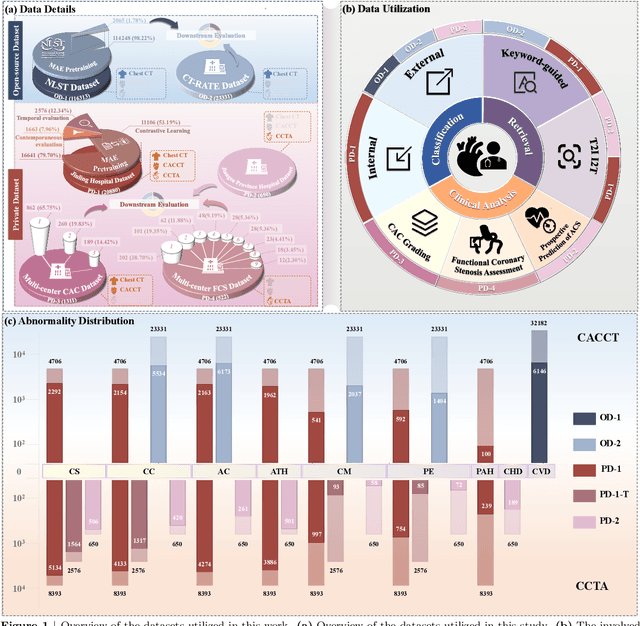

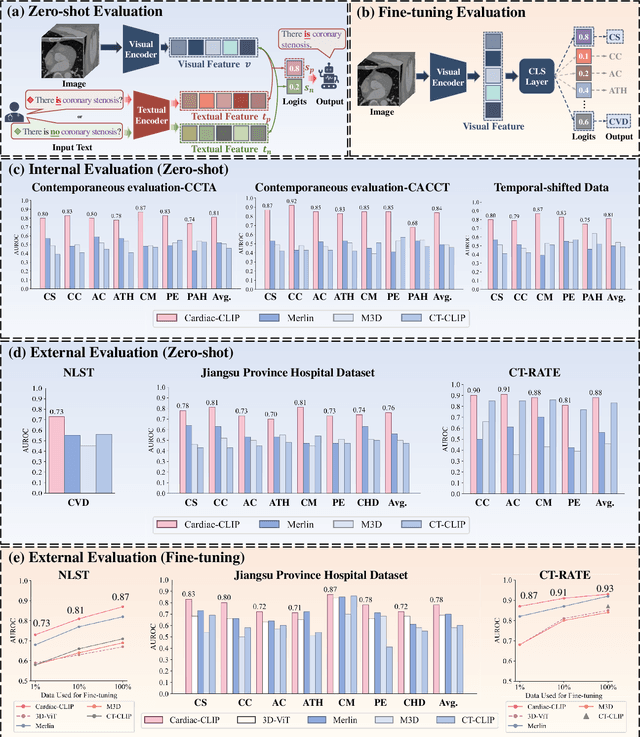
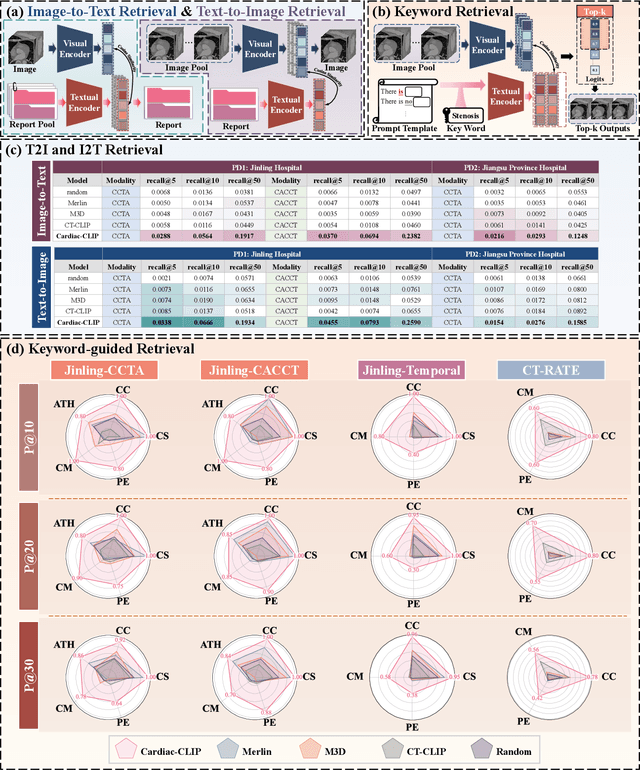
Foundation models have demonstrated remarkable potential in medical domain. However, their application to complex cardiovascular diagnostics remains underexplored. In this paper, we present Cardiac-CLIP, a multi-modal foundation model designed for 3D cardiac CT images. Cardiac-CLIP is developed through a two-stage pre-training strategy. The first stage employs a 3D masked autoencoder (MAE) to perform self-supervised representation learning from large-scale unlabeled volumetric data, enabling the visual encoder to capture rich anatomical and contextual features. In the second stage, contrastive learning is introduced to align visual and textual representations, facilitating cross-modal understanding. To support the pre-training, we collect 16641 real clinical CT scans, supplemented by 114k publicly available data. Meanwhile, we standardize free-text radiology reports into unified templates and construct the pathology vectors according to diagnostic attributes, based on which the soft-label matrix is generated to supervise the contrastive learning process. On the other hand, to comprehensively evaluate the effectiveness of Cardiac-CLIP, we collect 6,722 real-clinical data from 12 independent institutions, along with the open-source data to construct the evaluation dataset. Specifically, Cardiac-CLIP is comprehensively evaluated across multiple tasks, including cardiovascular abnormality classification, information retrieval and clinical analysis. Experimental results demonstrate that Cardiac-CLIP achieves state-of-the-art performance across various downstream tasks in both internal and external data. Particularly, Cardiac-CLIP exhibits great effectiveness in supporting complex clinical tasks such as the prospective prediction of acute coronary syndrome, which is notoriously difficult in real-world scenarios.
HAMLET-FFD: Hierarchical Adaptive Multi-modal Learning Embeddings Transformation for Face Forgery Detection
Jul 28, 2025The rapid evolution of face manipulation techniques poses a critical challenge for face forgery detection: cross-domain generalization. Conventional methods, which rely on simple classification objectives, often fail to learn domain-invariant representations. We propose HAMLET-FFD, a cognitively inspired Hierarchical Adaptive Multi-modal Learning framework that tackles this challenge via bidirectional cross-modal reasoning. Building on contrastive vision-language models such as CLIP, HAMLET-FFD introduces a knowledge refinement loop that iteratively assesses authenticity by integrating visual evidence with conceptual cues, emulating expert forensic analysis. A key innovation is a bidirectional fusion mechanism in which textual authenticity embeddings guide the aggregation of hierarchical visual features, while modulated visual features refine text embeddings to generate image-adaptive prompts. This closed-loop process progressively aligns visual observations with semantic priors to enhance authenticity assessment. By design, HAMLET-FFD freezes all pretrained parameters, serving as an external plugin that preserves CLIP's original capabilities. Extensive experiments demonstrate its superior generalization to unseen manipulations across multiple benchmarks, and visual analyses reveal a division of labor among embeddings, with distinct representations specializing in fine-grained artifact recognition.
 Add to Chrome
Add to Chrome Add to Firefox
Add to Firefox Add to Edge
Add to Edge